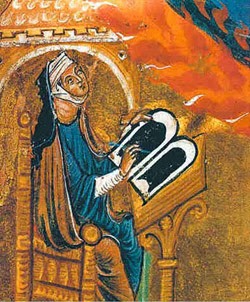(This image of Hildegard of Bingen shows her recording her visions, the image comes from Scivias, her first written work.)
From
our discussions in class on Wednesday and Friday, I have been thinking a lot
about mystics and their individualized nature. We mentioned that many women may
share a few common ideas or facts, but largely stood separately from one
another. One thing we did not discuss in class but was in the reading refers to
the differences between early mystics and beguine mystics. The quote itself
reads, “in Hildegard’s writings, ‘the soul, at the summit of the vision,
becomes similar to God,’ while for beguines ‘the soul is annihilated to become ‘what
God is’’” (CP 132). The reason this is so interesting is that it offers two
very distinct ideas concerning the soul during a vision. One suggests becoming
like God, in the other the soul is destroyed.
Within
such a dichotomy it is not surprising that women mystics tended to act
differently whether beguine or not. For those of you who cannot remember
beguines were women who led lives of religious devotion, without joining a
religious order. The reason this distinction is needed is that these
women had a little more freedom than their counterparts who took vows with an
order. The reason the above quote interested me so much centers on the
differences. For those women tied to an order the soul becomes similar to God,
but retains its separation. The beguines lost their souls to become the same as
God. Could this be due to the beguines not being tied to an order, so they
believe their ability to become like god instead of just a soul that offers a
similar understanding to what God is? The similar language but distinct
differences between becoming similar to God and to becoming God make these
women understand their visions very differently. Another thought is the
beguines because they were not tied to an order sought to more fully recognize
the power of God in annihilating their souls to give them information through
these visions. By placing all the power in God, the beguines may have received
better acceptance in to culture, instead of saying they held on to a level of
agency.

